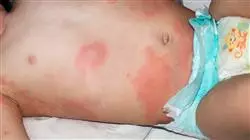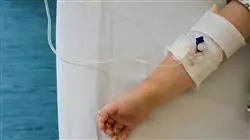University certificate
The world's largest faculty of nursing”
Introduction to the Program
This program will generate a sense of confidence in the performance of healthcare practice, which will help you grow personally and professionally"

The objective of this Postgraduate certificate in Infectious Diseases in the Emergency Department of the Pediatric Patient for Nursing is to train professionals who in their daily practice may encounter situations of this type. In this way, they will gain specific knowledge that will enable them to react appropriately to cases in which they will have to prove their worth, for their own sake and, above all, for the sake of their patients.
To this end, TECH has designed this complete training course aimed at specializing nurses in infectious diseases that affect children and that, due to their complexity or because they have symptoms that can be harmful to children, end up being treated in the Emergency Department. Thus, the program includes the classic aspects in the management of infectious pathology by apparatus or organs, as well as new items essential for the correct management of Infectious Diseases in the current scenario of globalization of health. But, as it could not be otherwise, the main content is aimed at knowing the main Infectious Diseases that affect children in order to know the best way to take care of them. The fact is that the complexity that can be involved in the urgent care of pediatric patients with infectious diseases requires a high level of specialization to train healthcare professionals.
On the other hand, being a 100% online training, the professional will have the ability to decide when and from where to study, without commitments or obligations, thus being able to combine their study time with the rest of their daily obligations.
Specialize with us and increase your training in the field of pediatric infections, achieving improvements in your patients”
This Postgraduate certificate in Infectious Diseases in the Emergency Department of the Pediatric Patient for Nursing contains the most complete and up-to-date scientific program on the market. The most important features include:
- Clinical cases presented by experts in Infectious Diseases
- The graphic, schematic, and eminently practical contents with which they are created provide scientific and practical information on the disciplines that are essential for professional
- Therapeutic developments on the intervention in Infectious Diseases
- Practical exercises where to carry out the self-assessment process to improve learning
- An algorithm-based interactive learning system for decision-making in the clinical situations presented throughout the course
- Its special emphasis on research methodologies
- Theoretical lessons, questions to the expert, debate forums on controversial topics, and individual reflection assignments
- Content that is accessible from any fixed or portable device with an Internet connection
We offer you the best teaching methodology to train you with simulated cases that will allow you to improve your daily performance"
Its teaching staff includes professionals belonging to the nursing field, who contribute their work experience to this specialization, as well as renowned specialists belonging to leading scientific societies.
The multimedia content, developed with the latest educational technology, will provide the professional with situated and contextual learning, i.e., a simulated environment that will provide an immersive training experience designed to train for real-life situations.
The design of this program focuses on Problem-Based Learning, by means of which the nurse must try to solve the different professional practice situations that arise throughout the academic year. For this purpose, the professional will be assisted by an innovative interactive video system developed by recognized experts in the field of Infectious Diseases in Pediatric Patients with extensive teaching experience.
Increase your decision-making confidence by updating your knowledge through this Postgraduate certificate"

Take the opportunity to learn about the latest advances in Infectious Diseases in the Pediatric Patient for Nursing and improve the care of your patients"
Why study at TECH?
TECH is the world’s largest online university. With an impressive catalog of more than 14,000 university programs available in 11 languages, it is positioned as a leader in employability, with a 99% job placement rate. In addition, it relies on an enormous faculty of more than 6,000 professors of the highest international renown.

Study at the world's largest online university and guarantee your professional success. The future starts at TECH”
The world’s best online university according to FORBES
The prestigious Forbes magazine, specialized in business and finance, has highlighted TECH as “the world's best online university” This is what they have recently stated in an article in their digital edition in which they echo the success story of this institution, “thanks to the academic offer it provides, the selection of its teaching staff, and an innovative learning method aimed at educating the professionals of the future”
A revolutionary study method, a cutting-edge faculty and a practical focus: the key to TECH's success.
The most complete study plans on the university scene
TECH offers the most complete study plans on the university scene, with syllabuses that cover fundamental concepts and, at the same time, the main scientific advances in their specific scientific areas. In addition, these programs are continuously being updated to guarantee students the academic vanguard and the most in-demand professional skills. In this way, the university's qualifications provide its graduates with a significant advantage to propel their careers to success.
TECH offers the most comprehensive and intensive study plans on the current university scene.
A world-class teaching staff
TECH's teaching staff is made up of more than 6,000 professors with the highest international recognition. Professors, researchers and top executives of multinational companies, including Isaiah Covington, performance coach of the Boston Celtics; Magda Romanska, principal investigator at Harvard MetaLAB; Ignacio Wistumba, chairman of the department of translational molecular pathology at MD Anderson Cancer Center; and D.W. Pine, creative director of TIME magazine, among others.
Internationally renowned experts, specialized in different branches of Health, Technology, Communication and Business, form part of the TECH faculty.
A unique learning method
TECH is the first university to use Relearning in all its programs. It is the best online learning methodology, accredited with international teaching quality certifications, provided by prestigious educational agencies. In addition, this disruptive educational model is complemented with the “Case Method”, thereby setting up a unique online teaching strategy. Innovative teaching resources are also implemented, including detailed videos, infographics and interactive summaries.
TECH combines Relearning and the Case Method in all its university programs to guarantee excellent theoretical and practical learning, studying whenever and wherever you want.
The world's largest online university
TECH is the world’s largest online university. We are the largest educational institution, with the best and widest online educational catalog, one hundred percent online and covering the vast majority of areas of knowledge. We offer a large selection of our own degrees and accredited online undergraduate and postgraduate degrees. In total, more than 14,000 university degrees, in eleven different languages, make us the largest educational largest in the world.
TECH has the world's most extensive catalog of academic and official programs, available in more than 11 languages.
Google Premier Partner
The American technology giant has awarded TECH the Google Google Premier Partner badge. This award, which is only available to 3% of the world's companies, highlights the efficient, flexible and tailored experience that this university provides to students. The recognition as a Google Premier Partner not only accredits the maximum rigor, performance and investment in TECH's digital infrastructures, but also places this university as one of the world's leading technology companies.
Google has positioned TECH in the top 3% of the world's most important technology companies by awarding it its Google Premier Partner badge.
The official online university of the NBA
TECH is the official online university of the NBA. Thanks to our agreement with the biggest league in basketball, we offer our students exclusive university programs, as well as a wide variety of educational resources focused on the business of the league and other areas of the sports industry. Each program is made up of a uniquely designed syllabus and features exceptional guest hosts: professionals with a distinguished sports background who will offer their expertise on the most relevant topics.
TECH has been selected by the NBA, the world's top basketball league, as its official online university.
The top-rated university by its students
Students have positioned TECH as the world's top-rated university on the main review websites, with a highest rating of 4.9 out of 5, obtained from more than 1,000 reviews. These results consolidate TECH as the benchmark university institution at an international level, reflecting the excellence and positive impact of its educational model.” reflecting the excellence and positive impact of its educational model.”
TECH is the world’s top-rated university by its students.
Leaders in employability
TECH has managed to become the leading university in employability. 99% of its students obtain jobs in the academic field they have studied, within one year of completing any of the university's programs. A similar number achieve immediate career enhancement. All this thanks to a study methodology that bases its effectiveness on the acquisition of practical skills, which are absolutely necessary for professional development.
99% of TECH graduates find a job within a year of completing their studies.
Postgraduate Certificate in Infectious Diseases in the Emergency Department of the Pediatric Patient for Nursing
The care of children in the emergency department is a complex task that requires professionals with great skills, not only for their treatment, but also to perform a personalized care to reassure the little ones. Pediatric infections require nurses with updated knowledge, so that their intervention can favor the recovery of patients, that is why TECH Global University offers the Postgraduate Certificate in Infectious Diseases in the Emergency Department of the Pediatric Patient for Nursing, an academic program designed for nurses with experience in the pediatric area who wish to expand their knowledge and skills in the management of infectious diseases in critical situations. The program focuses on the early recognition and effective treatment of infectious diseases in children requiring emergency care. Participants will learn about the epidemiology and etiology of common and emerging infections, as well as clinical guidelines and protocols for the management of infections in pediatric patients.
Participants will learn about the epidemiology and etiology of common and emerging infections, as well as clinical guidelines and protocols for the management of infections in pediatric patients.
Take your nursing career to another level at TECH
The Postgraduate Certificate in Infectious Diseases in the Emergency Department of the Pediatric Patient for Nursing will also address topics such as prevention and control of airborne infections and identification of antibiotic-resistant pathogens. Nursing professionals will also learn about the rational use of antibiotics and the prevention of bacterial resistance. The academic program is designed to be accessible and flexible for working nurses. It consists of a series of online courses and the best tools for learning that only TECH offers you. In summary, the Postgraduate Certificate in Infectious Diseases in the Emergency Department of the Pediatric Patient for Nursing is an excellent training opportunity for experienced pediatric nurses looking to improve their skills in the management of infectious diseases in critical situations. With the training, participants will be able to provide quality care and help save lives of pediatric patients in critical situations.







